RV ADVICE from KOA
THE BEST GUIDE TO RV CAMPING IN WINTER

YOUR GUIDE TO COLD WEATHER RV CAMPING
While some pack up their RV and head south in the winter, others stick around to enjoy the sparkling snow, peaceful woods and quiet campgrounds. Winter RV camping offers a break from the bustling summer season and a chance to relax in the beautiful snowy outdoors. Winter RV trips can be an affordable way to explore a popular ski destination or enjoy other outdoor winter recreation. If you are considering taking your RV out this winter, don’t let the cold weather get in your way. Use this guide to cold weather RVing to stay warm and safe during your wintertime RV camping adventure.
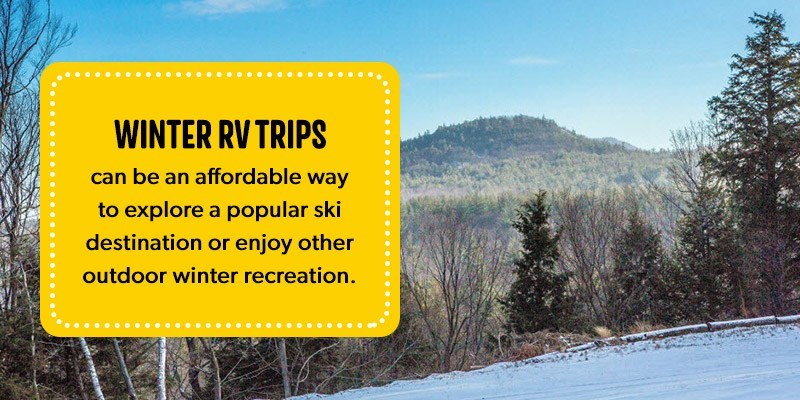
PREPARING FOR WINTER RVING
Before you embark on a winter RV trip, make sure your camper is in the best condition to face the cold. By preparing your camper for harsh weather, you can protect your engine and other RV components from freezing and other damage. An adequately insulated RV will keep you and your family warm to make your winter camping experience more comfortable and enjoyable. Below are five ways to prepare your RV for a winter camping trip.
1. INSTALL AND UPGRADE RV INSULATION
Installing insulation is one of the best and simplest ways to keep a camper warm in the winter. RV insulation protects many vehicle components from damage and helps create a warm and toasty living space. Insulation around the base of the RV can also effectively block cold winter winds from damaging RV piping and sucking heat out of the camper. If you are heading out for a winter RV camping trip, try these tips for how to insulate a camper trailer and RV underbelly for cold weather camping:
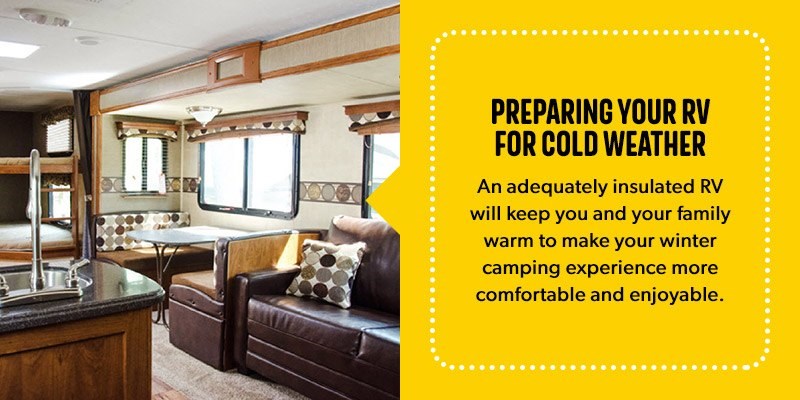
- Seal the windows and doors. Examine the seals and caulking around your RV windows and replace any areas that are missing or weak. Replace weather stripping around exterior doors to prevent cold air or moisture from leaking in.
- Install window covering. Window film and reflective foil are affordable and effective ways to further insulate your RV windows. Foil-lined reflective insulation can be cut to fit your RV windows and has the added bonus of reflecting heat back into the camper.
- Use heavy drapes. Thick fabric drapes block cold drafts around windows and keep warm air in during chilly evenings. Insulated curtains can also be used to separate the cockpit and living space, so you have a smaller area to heat.
- Insulate the floors. Foam board flooring can be used to insulate the RV floor. If you prefer not to purchase foam board flooring, heavy rugs or carpets can also help block cold air that may come up.
- Install RV skirting. Wind blowing underneath your RV can cause water tanks to freeze and suck heat out. Installing RV skirting around the base of the RV can block cold winds from damaging vehicle components and chilling the interior. Foam boards can also be used with or instead of skirting to better insulate the base of your RV.
Most RV insulation can remain installed throughout the year and requires very little yearly maintenance. Window foil insulation can be easily rolled up and stored during warmer months, and RV skirting can be used year round or stored in the summer.
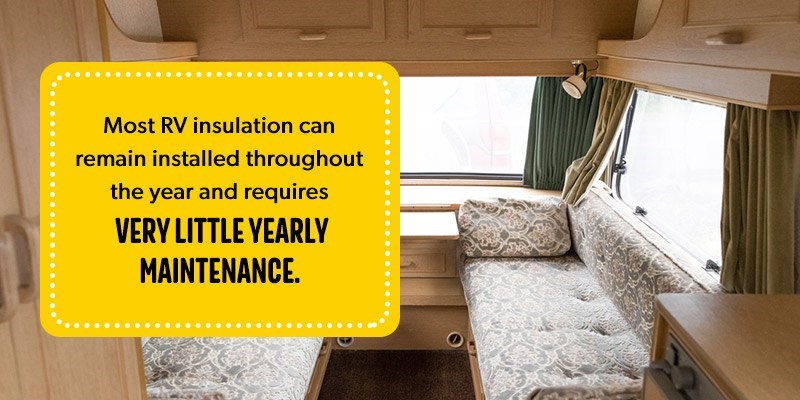
2. PROTECT YOUR RV PLUMBING
Freeze-ups are a common challenge for winter RV camping and can lead to plumbing damage. When ice expands in pipes and hoses, it can cause them to crack or burst if not properly insulated. Keep your water flowing this winter by following these tips for keeping RV pipes from freezing while camping:
- Use heat tape on pipes and hoses. Wrap your freshwater hose and sewer hose with heat strips to keep the lines warm and prevent freezing. Heat tape can be applied around valves and connections most at risk of freeze-ups. You can also add foam insulation in addition to heat tape for extra protection.
- Warm your internal plumbing. Open your bathroom and kitchen cabinets, so your trailer’s heating can keep your internal plumbing warm. Allowing a small drip from faucets can also help combat freezing by keeping water moving.
- Use the internal freshwater tank. Instead of connecting your RV to external water sources, fill the internal freshwater tank to use as your primary water source. This allows you to disconnect and safely store your freshwater hose.
- Use a space heater. If your RV water lines or water pump are not protected by a heat source, you can also use a small space heater to help prevent freezing. Practice safety precautions by keeping space heaters the appropriate distance away from RV components and vents.
- Add antifreeze. Adding a small amount of antifreeze in holding tanks can protect the valves from freezing.
- Dump tanks wisely. Only dump tanks when they are full to reduce the risk of freezing. Keep waste valves closed when not in use.
3. TAKE CARE OF YOUR RV ENGINE
RV engines and engine components need extra protection to withstand extreme winter temperatures. Before heading out for winter RV camping, inspect your RV batteries for any signs of corrosion or damage. Make sure your batteries are fully charged and securely connected. Batteries that are only partly charged are much more likely to freeze or die in cold temperatures.
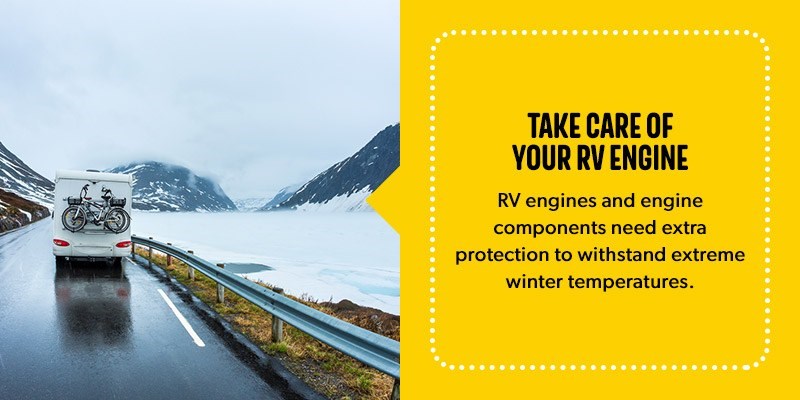
Check your engine antifreeze and refill it with the proper concentration of antifreeze and water. While water may be effective for cooling an engine in warmer months, using at least 50 percent antifreeze is essential for RV camping in freezing temperatures. For camping in very cold regions, using an engine block heater can provide additional protection. Engine block heaters are meant to warm up your engine before you start it, and should run for about four to five hours prior to starting the engine if the temperature is below freezing.
4. PREPARE YOUR RV FURNACE
Check your RV furnace before your winter camping trip to ensure it is in proper working condition. If camping in extremely cold temperatures, it is best to have an inspection performed by a certified RV repair technician. Clean your furnace using compressed air or a soft brush to remove dirt and debris. Check the furnace vents for any damage or obstructions that could prevent air from flowing properly and check that the furnace air return is not blocked.
When heating your RV in winter, you may also choose to use additional heat sources. Space heaters and catalytic heaters can make a huge difference for staying warm in a camper in winter. Remember that these heating methods can add moisture to the air which may cause damage to your engine and other RV components. Condensation in the engine or pipes can cause corrosion, and moisture inside your RV may lead to mold. Use a dehumidifier to remove excess moisture if necessary and keep your RV warm and dry.
5. OTHER TIPS FOR WINTERIZING YOUR RV
When operating and living in a travel trailer during winter, there are many precautions you can take to prevent freeze-ups and stay warm. Here are a few more tips for preparing your RV for a cold weather trip:
- Prevent stabilizing jacks from freezing. When parking your camper in snowy or icy conditions, your stabilizing jacks may get stuck to the cold ground. Place wooden blocks underneath the jacks to prevent them from sticking.
- Cover your AC unit. When camping in the winter, you will not need to run your RV air conditioning. Using an insulated AC cover can protect your AC unit while it is not in use and prevent cold drafts.
- Install vent covers. RV vent covers allow you to keep your air vents open in any weather without snow or rain getting into the trailer. Having the air vents open reduces the risk of carbon monoxide poisoning if you run a portable heater inside your camper, and the open vents can release humidity to keep your RV dry, too.
- Take care with plastic components. In extremely cold temperatures, plastic parts of your RV, such as levers and trim, may become brittle. Handle plastic components with care to prevent breakage.
- Change batteries in safety devices. When running space heaters inside your RV, it is essential that carbon monoxide detectors and fire alarms are working as they should. Test these safety devices and change the batteries before your winter trip.

WHAT TO PACK FOR A WINTER RV TRIP
When packing for winter travel trailer camping, it is best to prepare for even colder weather than you expect and bring back-up supplies in case of an emergency. Winter weather can be unpredictable, so prepare for a winter storm even if clear weather is in the forecast. Pack an emergency kit that includes anything you may need to repair your RV should a freeze-up or breakdown occur. When choosing clothing for your winter RV camping, look for waterproof and insulated options. Prepare for any adventure by bringing several different layers, and remember that you can always take layers off if the temperature rises. Use this winter RV camping checklist when packing for your cold weather camping trip:
- Breathable base layer: Pack a few base layers that are made of materials that will wick away moisture but still provide sufficient warmth. When playing outdoors and working up a sweat, it is important to keep your core warm and dry.
- Variety of mid layers: Prepare for fluctuating winter temperatures by packing several different base layers made of insulating and breathable materials, like fleece and wool.
Waterproof outer layer: Choose a winter coat that is waterproof and sufficiently warm to protect against snow and freezing rain. - Warm hat and socks: A lot of body heat can escape from your head and feet if they are not protected. Choose a warm hat and socks to stay cozy in cold temperatures.
Extra blankets and clothes: When the temperature drops in the evening, you can bundle up with extra blankets and warm clothes. If you get wet in the snow or rain, extra clothing is essential to keep you warm.
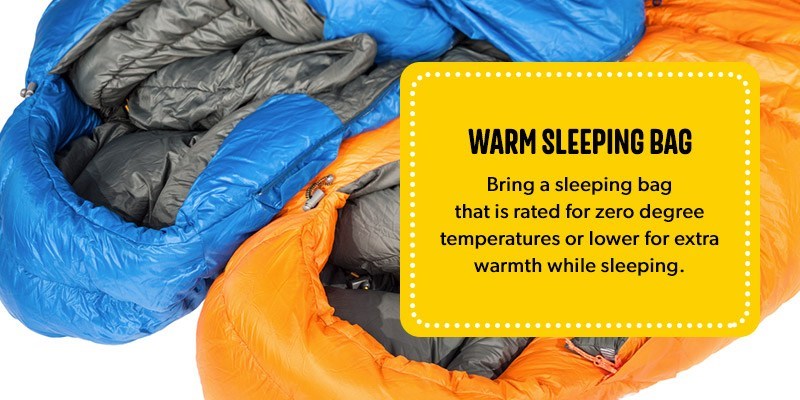
- Warm sleeping bag: Bring a sleeping bag that is rated for zero degree temperatures or lower for extra warmth while sleeping.
- Waterproof gloves: Waterproof and insulated gloves or mittens are perfect for playing in the snow or hiking in cold weather.
- Snow boots: Waterproof snow boots are a must for walking outside in snowy and wet conditions.
- Goggles: If you plan to snowboard, ski or snowshoe, goggles will protect your eyes from cold wind and blowing snow. If you get caught in a snowstorm, goggles will make it easier to navigate outdoors if necessary.
- Headlamp and lantern: The sun sets earlier in the winter, so you may get caught in the dark when hiking or exploring outdoors. Bring a headlamp to navigate your campsite in the evening. A battery-powered lantern can also help light up your campsite at night.
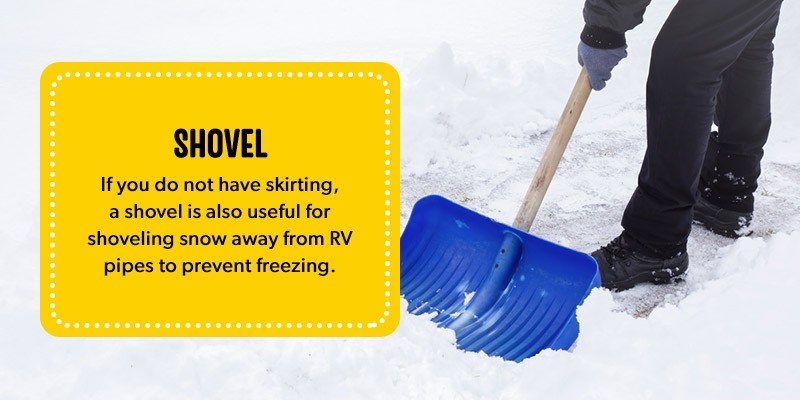
- Shovel: When RV camping in the winter, you may need to dig your camper out of the snow. If you do not have skirting, a shovel is also useful for shoveling snow away from RV pipes to prevent freezing.
- Tire chains: If you get caught driving in the snow, RV tire chains can greatly improve traction on mountain roads.
- Extra propane tanks: If you plan to use your RV furnace to heat your trailer, bring extra propane tanks in case you run out. If using a portable heater, bring extra fuel so you will not be caught in the cold.
- Extra drinking water and food: Bring a few gallons of extra drinking water in case of an emergency. Be sure to store your water in a warm location. Bring a few days worth of extra food in case a snowstorm delays your trip.
- Blow dryer: If pipes or hoses freeze, a blow dryer can be great for defrosting RV components.
HOW TO KEEP YOUR RV OR CAMPER WARM IN THE WINTER
After long days of enjoying the outdoors, you will want to return home to a warm and cozy camper. When temperatures drop in the evening, staying warm in your RV is even more important. If you have prepared your RV before your trip, the exterior insulation and skirting can greatly increase your trailer’s internal temperature. Insulating all seams, vents, windows and doors will lock in the warmth from your RV furnace. If it snows during your camping trip, be sure to keep the roof clear. Snow piling up on the RV roof can cause stress to the roof as well as make the trailer colder.
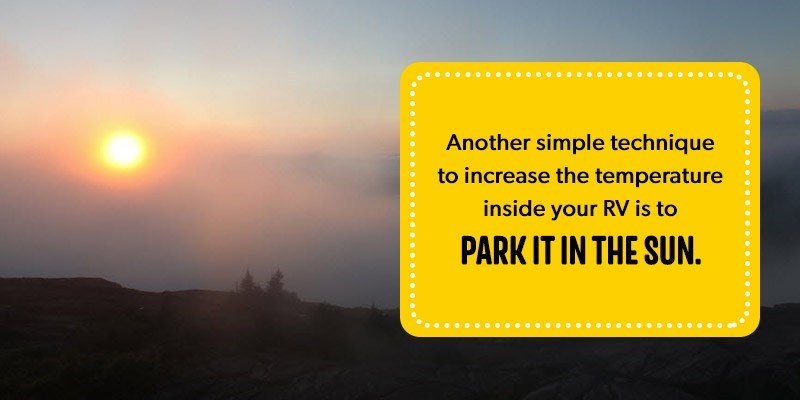
Another simple technique to increase the temperature inside your RV is to park it in the sun. A sunny campsite allows the sun to naturally heat your RV and help melt any snow on the roof of your trailer. A spot with some protection from wind also helps to keep your RV warm. If you do have to park in a windy area, position your RV so the wind hits the front of the RV rather than the sides.
In less severe winter temperatures, running your RV furnace will likely be sufficient to keep your RV warm. Using the RV furnace has the benefit of keeping your water pipes and hoses warm to further prevent freezing. Because your RV furnace pulls outside air into the RV, it also poses no risk of carbon monoxide poisoning. However, RV furnaces may not be as efficient as other heating alternatives and can also be fairly noisy when you are trying to sleep. If temperatures dip too low, using an RV furnace alone may not be sufficient to keep you and your family warm. In very cold temperatures, use additional heaters inside your RV to make your winter camping trip more comfortable. There are a few different types of heaters to consider for heating your RV in winter:
- Catalytic heaters. Catalytic heaters are one of the safest ways to heat your RV in the winter because, unlike portable heaters that use fuel, catalytic heaters use chemical reactions to produce heat. This means that catalytic heaters do not produce dangerous carbon monoxide gas and are safer for use indoors.
- Electric heaters. If your campsite has an electric hook-up, using an electric heater can be a great option. Small electric heaters can be used to keep sleeping areas warm at night without turning the main furnace up too high. If using an electric heater, be aware of fire risk and follow all safety instructions closely.
- Portable heater. For campsites without electricity, portable space heaters are an effective heating option, but they must be used with caution. Portable heaters that use gasoline or another fuel must be used with proper ventilation to prevent carbon monoxide poisoning. If you are using a portable heater in your RV, be sure your carbon monoxide detector is working and keep your RV air vents open at all times.
After you get your RV warmed up, be sure to keep yourself warm too. Even the toughest outdoor enthusiasts are not immune to frostbite and hypothermia, so bundle up anytime you go outdoors in cold weather. Hand and feet warmers can also be tucked into your gloves and boots to keep your extremities warm. If you get wet while adventuring outdoors, change into dry clothing as soon as you get inside. While sleeping in your RV, use a sleeping bag and extra blankets to trap body heat and stay cozy. For extra warmth, consider using a heating pad, electric blanket or hot water bottle in your bed.
OTHER TIPS FOR WHEN YOU’RE ON THE ROAD AND AT THE CAMPSITE
Winter RV camping can be a unique and thrilling experience. With the right preparation, you can enjoy the beauty of the winter landscape and excitement of winter recreation while staying warm and safe. Here are a few more tips for planning the best winter RV camping trip:
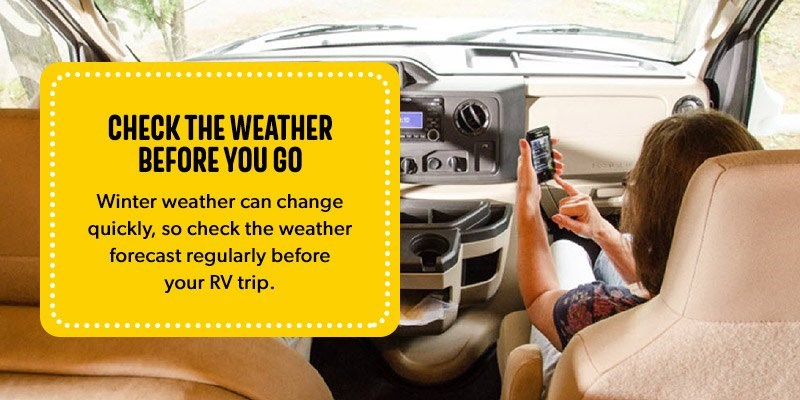
- Check the weather before you go. Winter weather can change quickly, so check the weather forecast regularly before your RV trip. If a winter storm appears or driving conditions seem unsafe, consider rescheduling your trip or choosing a different destination. Knowing the weather forecast will also help you pack appropriately for the expected temperature. Always bring clothing that will keep you warm in temperatures lower than what is predicted, so you’ll stay comfortable no matter the weather.
- Check what is open. Many campgrounds close for the winter, while others stay open all year round. Before heading out, make sure your campground is open. You may also want to verify that any national parks, trails or other attractions in the area will be available when you are there.
- Watch for black ice while traveling. When driving to your destination, be on the lookout for black ice. Black ice typically occurs in shaded areas and near bridges. If you do hit black ice, keep your RV pointed straight ahead and try not to hit the brakes, as that can lead to a spin out.
- Keep your gas tank full. When traveling in cold weather, keep your gas tank at least half full at all times. This improves engine performance and helps prevent ice crystals from forming due to condensation in the empty space of the gas tank.
- Keep your plans flexible. To make the most of your winter RV trip, keep your camping itinerary flexible. If you planned outdoor activities, but it is too cold or snowy, be prepared with backup activities you can enjoy while inside your RV. Classic board games, movies or crafts can be fun for you and your family if you get snowed in. If you planned to stay indoors but get lucky with beautiful winter weather, have warm clothes on hand so you can venture outdoors.
- Have fun. Remember that at the end of the day, camping should be fun! If your RV gets too cold during your winter camping trip, there is no shame in heading into the campground facilities to warm up or booking a cabin instead of shivering outdoors. But if you love winter RV camping, then facing some snow and cold is worth it to enjoy the beautiful outdoors all winter long.

CHECK OUT KOA CAMPGROUNDS THIS WINTER
If you are planning an RV trip this winter, choose a Kampgrounds of America campground that is open through the winter months. KOA has more that 250 campgrounds that are open year-round, including both northern and southern campgrounds, so you can find your perfect winter destination whether you venture into the snow or head south chasing the sun.
KOA campgrounds are available near popular ski areas, hiking trails and national parks, so you can make the most of your winter adventure. Use our Find a KOA tool to locate a campground near your dream winter RV trip destination.
Ensure your RV is ready to hit the road this season and save on services that you regularly rely on with exclusive discounts from KOA Rewards. With KOA Rewards, you can save on Goodyear Tire services, RV insurance, RV or Boat loans, DISH Outdoor and more!
